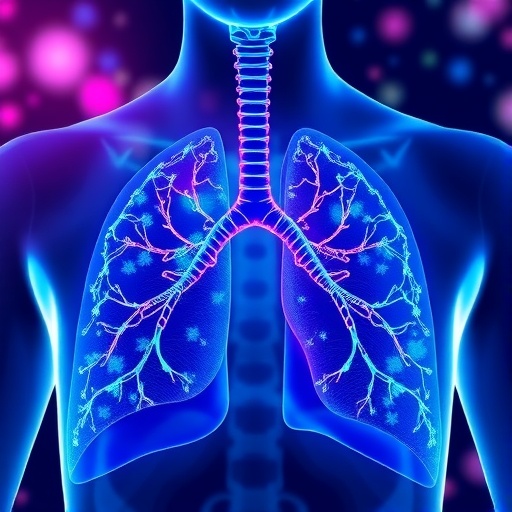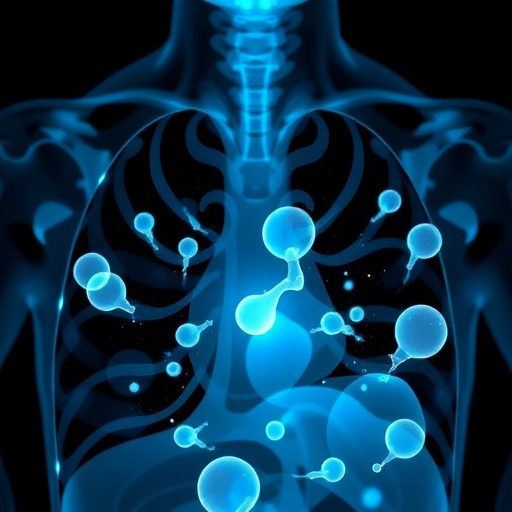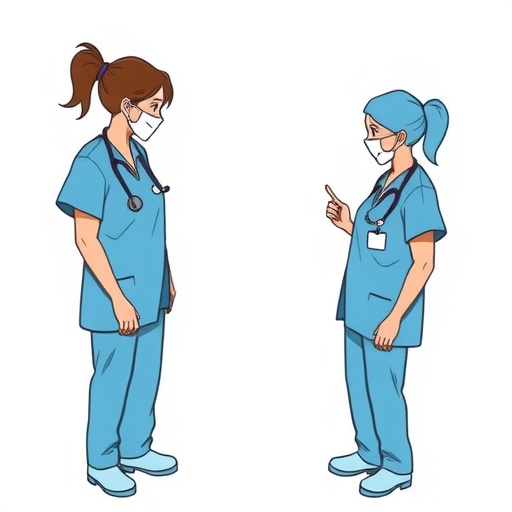In a groundbreaking study published recently in Nature Communications, researchers have delved into the intricate immune mechanisms responsible for the development of immunotherapy-induced pneumonitis in lung cancer patients. This research sheds crucial light on one of the most perplexing and potentially fatal side effects associated with immune checkpoint blockade therapies. These therapies, hailed for revolutionizing cancer treatment by harnessing the body’s immune system to attack tumors, are unfortunately marred by inflammatory toxicities, with pneumonitis being among the most serious. The study elucidates the cellular and molecular cascades within the immune system that precipitate lung tissue inflammation, paving the way for more effective patient management and the design of safer immunotherapeutic strategies.
Immunotherapy, particularly the administration of immune checkpoint inhibitors targeting proteins such as PD-1 and CTLA-4, has transformed lung cancer outcomes, extending survival for many advanced-stage patients. However, the flip side of this success has been the emergence of immune-related adverse events (irAEs), which arise when immune activation intended to fight cancer spills over into normal tissues. Pneumonitis, characterized by inflammation of lung parenchyma, can dramatically impair respiratory function and, in severe cases, lead to respiratory failure. Despite its clinical significance, the precise immunopathological mechanisms behind immunotherapy-associated pneumonitis remain poorly understood, hindering the development of predictive biomarkers and targeted interventions.
The team, led by Lin, X., Li, C., and Deng, J., employed a multifaceted approach combining advanced single-cell transcriptomics, spatial profiling, and functional immunology assays on samples from lung cancer patients who developed pneumonitis post immunotherapy. Their analyses identified distinct populations of immune cells infiltrating lung tissue, including hyperactivated T lymphocytes with a pro-inflammatory phenotype and aberrantly activated macrophages, which together create a self-sustaining inflammatory milieu. Remarkably, these immune cells exhibited gene expression profiles suggestive of dysregulated checkpoint signaling and chronic activation, indicating that therapies designed to invigorate antitumor immunity may inadvertently unleash pathogenic immune circuits in the lung microenvironment.
Further mechanistic investigations revealed an intricate interplay between innate and adaptive immune players. The researchers pinpointed a subset of CD8+ cytotoxic T cells expressing elevated levels of granzyme B and perforin, molecules typically involved in killing tumor cells, now implicated in collateral damage to lung epithelial cells. Additionally, these effector T cells produced excessive pro-inflammatory cytokines such as interferon-gamma (IFN-γ) and tumor necrosis factor-alpha (TNF-α), which amplify local inflammation and recruit additional immune effectors. Complementing this, lung-resident macrophages shifted towards a pro-inflammatory M1-like phenotype, producing chemokines that attract neutrophils and amplify tissue injury, disrupting the delicate balance required for lung homeostasis.
The researchers also uncovered that the cytokine milieu in pneumonitis patients diverged significantly from those without this complication. Elevated levels of interleukin-6 (IL-6), interleukin-17 (IL-17), and other inflammatory mediators suggested that an exaggerated inflammatory feedback loop was a key driver of lung pathology. Intriguingly, this cytokine profile bore resemblance to autoimmune and hyperinflammatory syndromes, underscoring the complexity of immune dysregulation triggered by checkpoint inhibitors. This finding highlights the potential benefit of repurposing immunomodulatory therapies, such as corticosteroids or IL-6 receptor antagonists, to mitigate pneumonitis without compromising antitumor immunity.
One of the study’s critical contributions lies in the identification of potential biomarkers predictive of pneumonitis onset. By integrating patient clinical data with molecular and cellular signatures, the authors propose a composite risk score based on immune cell infiltration patterns and serum cytokine levels. This score could enable oncologists to stratify patients before commencing immunotherapy, screening for those at heightened risk, and adjusting treatment protocols accordingly. Such proactive measures are vital for minimizing serious toxicities while preserving the transformative benefits of immunotherapy.
The implications of these findings extend beyond pneumonitis to other immune-related adverse events that challenge immunotherapy’s wider applicability. The study’s comprehensive characterization of immune dysregulation offers a blueprint for dissecting tissue-specific toxicities, advancing toward personalized cancer immunotherapy. Moreover, understanding how immune checkpoint inhibition disturbs pulmonary immune homeostasis has ramifications for managing lung inflammation in settings such as infections, autoimmunity, and transplant rejection.
In a broader context, this research exemplifies the power of single-cell and spatial technologies in unraveling complex pathologies at a resolution previously unattainable. By mapping immune cell states and their interactions within the native lung microenvironment, the team illuminated the dynamic processes fueling immunotherapy-induced pneumonitis. Their approach could be adapted to investigate other toxicities or even tumor microenvironment remodeling during therapy, catalyzing precision oncology.
Notably, the researchers emphasize the need for longitudinal studies to monitor immune evolution during immunotherapy and better capture the temporal dynamics of pneumonitis development. Prospective integration of immune profiling in clinical trials will be crucial for validating biomarkers and intervention strategies. Additionally, delving deeper into genetic and environmental factors influencing susceptibility to pneumonitis could uncover novel prevention avenues.
This landmark study not only advances fundamental knowledge of immune checkpoint-related lung toxicity but also underscores the delicate equilibrium between therapeutic immune activation and pathological inflammation. Achieving this balance remains a formidable challenge but one with enormous clinical payoff potential. As immunotherapies continue to transform oncology, parallel efforts to elucidate and mitigate their collateral immune damage will be indispensable for maximizing patient benefit.
Moving forward, combining immunotherapy with targeted immune modulators informed by mechanistic insights holds promise for enhancing efficacy and safety simultaneously. For instance, transiently damping specific cytokine pathways or selectively inhibiting deleterious immune cell subsets during therapy could quell pneumonitis risk without blunting antitumor responses. Developing such nuanced regimens will require multidisciplinary collaboration among immunologists, clinicians, and computational biologists.
Ultimately, this seminal work spearheaded by Lin and colleagues exemplifies precision medicine’s promise—harnessing detailed immune profiling to tailor cancer treatment intricacies and minimize harms. As the oncology community embraces increasingly sophisticated biotechnologies, the frontier between curing cancer and preserving patient quality of life grows ever narrower. Robust mechanistic understanding of immunotherapy toxicities will be key to straddling this frontier successfully.
In conclusion, uncovering the immune mechanisms driving immunotherapy-induced pneumonitis marks a pivotal step toward safer immuno-oncology. The constellation of hyperactivated cytotoxic T cells, pro-inflammatory macrophages, and dysregulated cytokine networks revealed here provide critical targets for predicting, monitoring, and intervening in this severe adverse event. As immune checkpoint blockade expands its transformative reach, translating these findings into clinical practice promises to improve outcomes for lung cancer patients worldwide, balancing oncologic triumph with immune homeostasis. This research heralds a new era of integrated, mechanism-based management of immunotherapy toxicities, heralding a safer future for cancer immunotherapy.
Subject of Research: Immune mechanisms underlying immunotherapy-induced pneumonitis in lung cancer patients
Article Title: Uncovering the immune mechanisms underlying the emergence of immunotherapy-induced pneumonitis in lung cancer patients
Article References:
Lin, X., Li, C., Deng, J. et al. Uncovering the immune mechanisms underlying the emergence of immunotherapy-induced pneumonitis in lung cancer patients.
Nat Commun (2025). https://doi.org/10.1038/s41467-025-66509-x
Image Credits: AI Generated
Tags: immune checkpoint inhibitorsimmune system mechanismsimmune-related adverse eventsimmunopathological mechanismsimmunotherapy pneumonitisinflammatory toxicities in cancerlung cancer treatmentlung tissue inflammationpatient management in cancerPD-1 CTLA-4 therapiesrespiratory function impairmentsafe immunotherapeutic strategies





